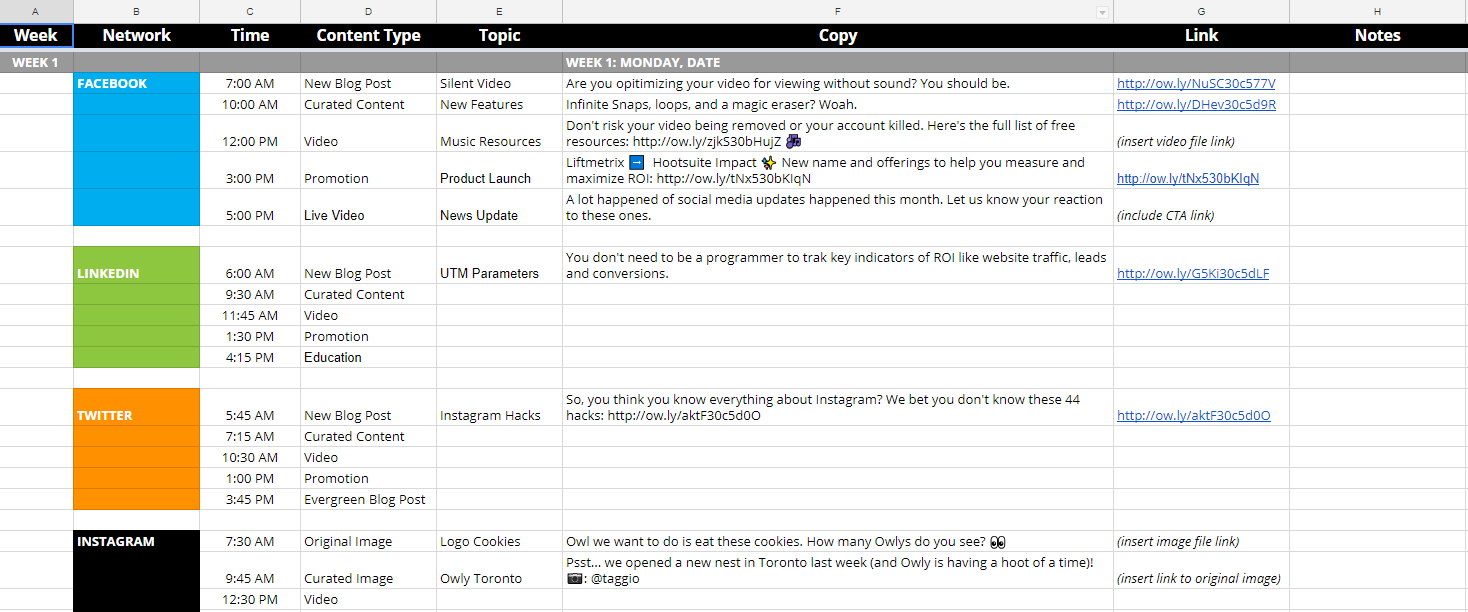This article was written as part of the SEMrush Big Blogging Contest.
Content marketers are often viewed as a creative bunch of individuals who play with words and visuals to drive traffic to their client’s website. While that’s a pretty accurate description, it doesn’t quite convey the full picture of what content marketing truly is.
Creativity is only part of the equation in being a successful content marketer. Sure, it brings new ideas to life and propels the campaign forward. But, it is data which guides the way.
Smart content marketing is a combination of creativity and analytics. Using data and analytics to define and refine content strategies is what smart marketers do.
Being data-driven helps create strong, result-oriented content and gives meaning to all your content marketing efforts at the end of the campaign. After all, content marketing is about adding value to your audience’s and your client’s life, isn’t it?
Read this guide to understand what I’m on about. It covers actionable guidelines centered around the use of data during each stage of the campaign to help you get the most out of your content marketing efforts.
Table of Contents |
Let’s get down to business.
Before Content Creation
You can either use your intuition and gut feeling to create content that you “feel” will resonate with your audience, or you can be data-driven and have a solid chance of getting a good ROI for your content efforts. In other words, before you start investing considerable time, effort, and resources in creating meaningful content, ask yourself the following questions:
- Why are you creating this content?
- Who is it for?
- What value will it add to your audience?
According to this source, over 4 million blog posts are published on the internet every day. Needless to say, there is already an information overload out there.

In order to stand out in this sea of content, you ought to create content which solves problems and is truly valuable to your audience, something which piques their curiosity, evokes strong emotions, and compels them to share.
Thus, you should proceed with content creation only if you have concrete answers to these questions. Now, once you do, here’s how you can leverage data to your advantage in creating a robust content strategy:
Understanding Your Audience
Do you know exactly who your target audience is? What their pain points and challenges are? Think carefully before you say yes, as creating content for the wrong audience could lead to a huge waste of time, money, and resources.

Now, here are a few data-driven approaches to precisely understand your target audience every time:
Creating a Buyer Persona
HubSpot defines buyer persona as “a semi-fictional representation of your ideal customer based on market research and real data about your existing customers.”
Be as detailed as possible when creating a buyer persona. Include key information such as their:
- Demographics: age, gender, location
- Job title
- Frustrations: what are their pain points?
- Motivations: what motivates them?
- Personality traits: do they enjoy a sense of humor or prefer to keep it professional?
- Goals
Below is an impressive example of a buyer persona created by OptinMonster:

You can also use your Google Analytics to determine where the majority of your visitors are coming from. Go to Audience > Overview > Demographics.
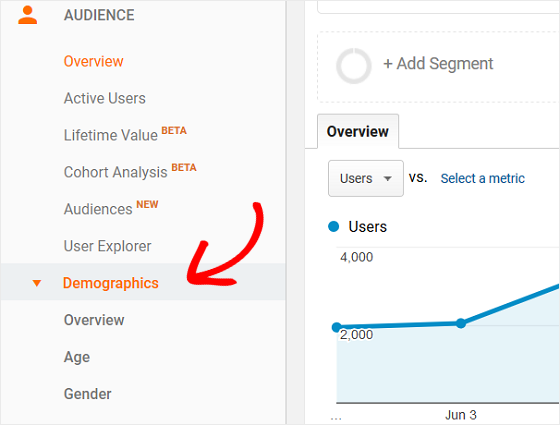
Performing Keyword Research with Focus on User Intent
I’m just going to go out on a limb and say you’re already aware of the “what, why, and how” of keyword research.
In a nutshell, you probably use any of the industry-standard tools like SEMrush’s Keyword Research, Moz’s Keyword Explorer, Ahrefs’ Keywords Explorer, or Google’s very own Keyword Planner; to compare metrics such as search volume, difficulty, and competition of a bunch of related keywords.
Collating keyword data in a spreadsheet is all well and good. But, today’s competition calls for you to take a step further than just rudimentary keyword research.

Focus on understanding what your user really wants to achieve. Top search results on Google don’t always answer the questions the user was really searching for. What is the crucial piece of information other content creators are missing?
Figure it out to give your content a unique value proposition. Also, answer their questions in the format they want: text, audio, or video.
Revisiting Google’s mission statement makes it crystal clear:
“To organize the world’s information and make it universally accessible and useful.”
So, it is time to go beyond matching keyword phrases and start ensuring your content comprehensively answers questions your audience is asking via search. Create content keeping the user intent in mind but at the same time technically optimized for indexing and ranking.
Use tools like Google Trends to see what search terms and keywords your audience is using to find what they are looking for.
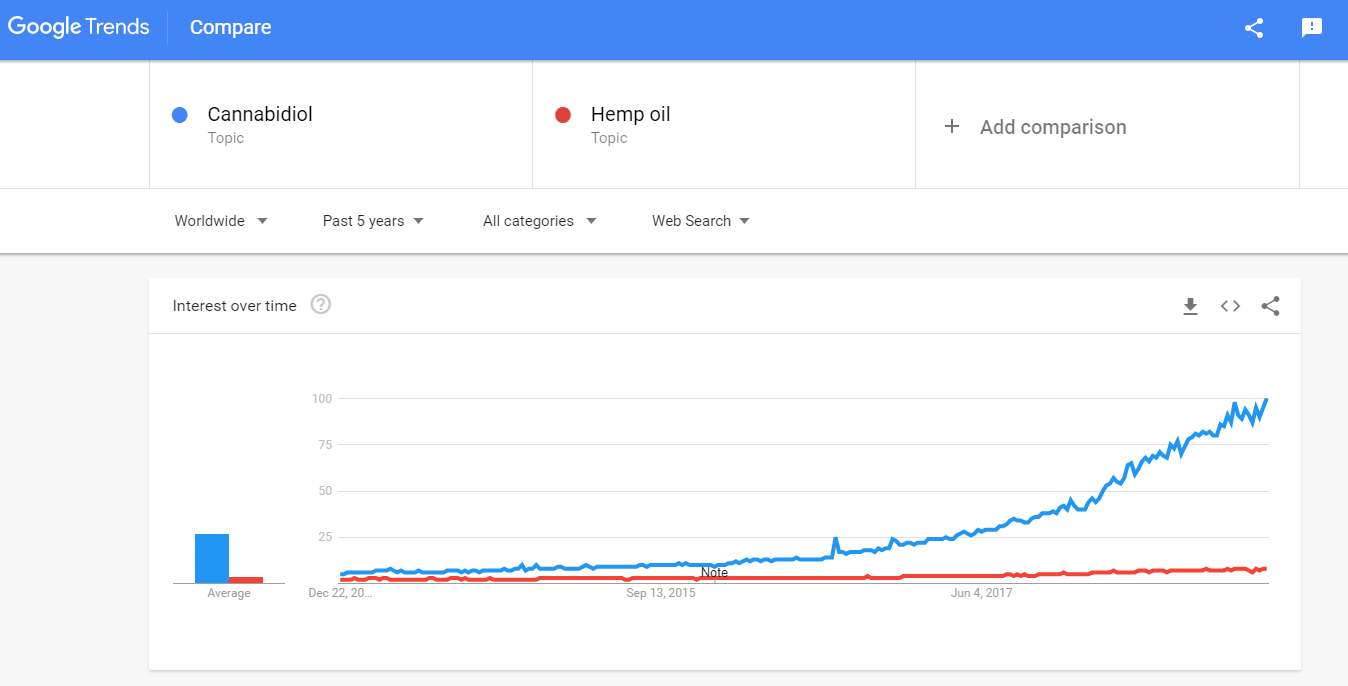
Take your research up a notch by using the little-known yet highly nifty Google Correlate. Using this tool, you can get an idea of the user’s search journey and make reasonable predictions on how they arrive at a particular search query. Learn more about how to use Google Correlate here.

Moreover, the search engine’s autocomplete feature itself provides good insights into how your audience searches for a particular topic. The search suggestions give you an idea behind the general intent of a given user.

Also, look out for the “People also ask” section where the most commonly asked questions related to the search query are answered. When creating content on that topic, try to answer as many such questions as you can and be thorough with your answers.
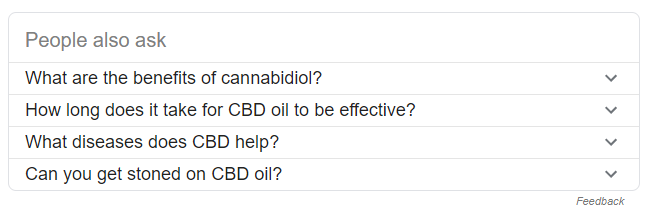
Lastly, check the related searches at the bottom of the results page to get even more topic ideas to cover in your content marketing strategy.
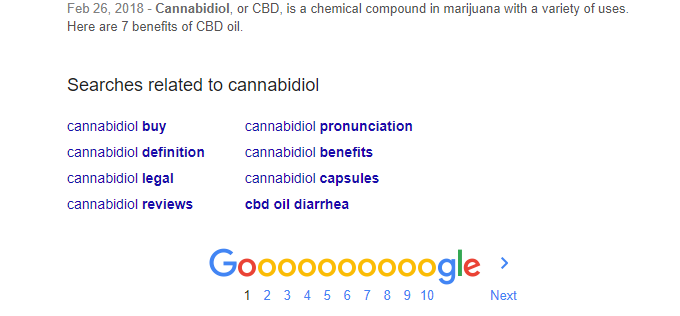
Surveying Your Audience
If you really want to create the most relevant and useful content for your audience, who better to ask than the audience themselves?
Surveying is the best way to create a data-driven content marketing strategy as all the data and feedback is curated directly from the audience (or customers).
Use tools like Jotform, Google Forms, SurveyMonkey, or Typeform to create simple surveys that ask invaluable questions, such as:
- What type of content do you enjoy consuming the most?
- What other blogs do you read in this industry and why?
- What do you think makes a fantastic blog post?
Furthermore, you can create accounts in forums and Q&A websites such as Reddit and Quora. Follow threads and topics relating to your niche where your ideal audience is likely to hang out and ask questions.

Also, a simple social listening strategy allows you to track online conversations around specific keywords, phrases, topics, brands, or industries. You can spot opportunities and gain new insights without engaging with the audience, and then tailor your content creation strategy according to the data acquired.
Creating a Content Calendar and Setting Goals
As you know, content marketing is a long-term investment. It takes consistency over a period of at least a few months before you start seeing measurable results. Preparing a content calendar before you actually start creating content is helpful in many ways:
- Planning different types of content such as blog posts, infographics, ebooks, and videos
- Assigning work and keeping track of deadlines
- Jotting down inspirational content ideas (which strike without notice) to keep them from slipping your mind
- Collecting content ideas while researching forums and Q&A websites
Below is a screenshot of a sample social media content calendar. Note how it clearly defines the social channel, time, content type, and topic.
Simply put, monitoring your campaign’s progress becomes very straightforward when you centralize all your data into something as simple as a spreadsheet.
During Content Creation
Apart from strategizing content creation and measuring the success of your campaign, data can also help you through the creative process itself.
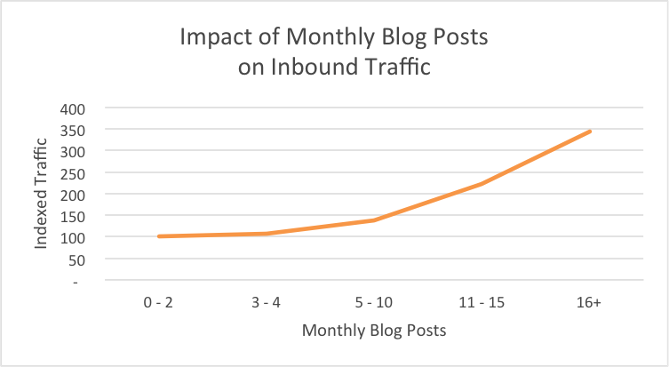
Data confirms companies that write more than 16 blog posts a month get nearly 3.5 times more traffic than those that publish between 0 to 4 posts per month. This reinforces the already mentioned point: consistency in producing fresh content is key to content marketing success.
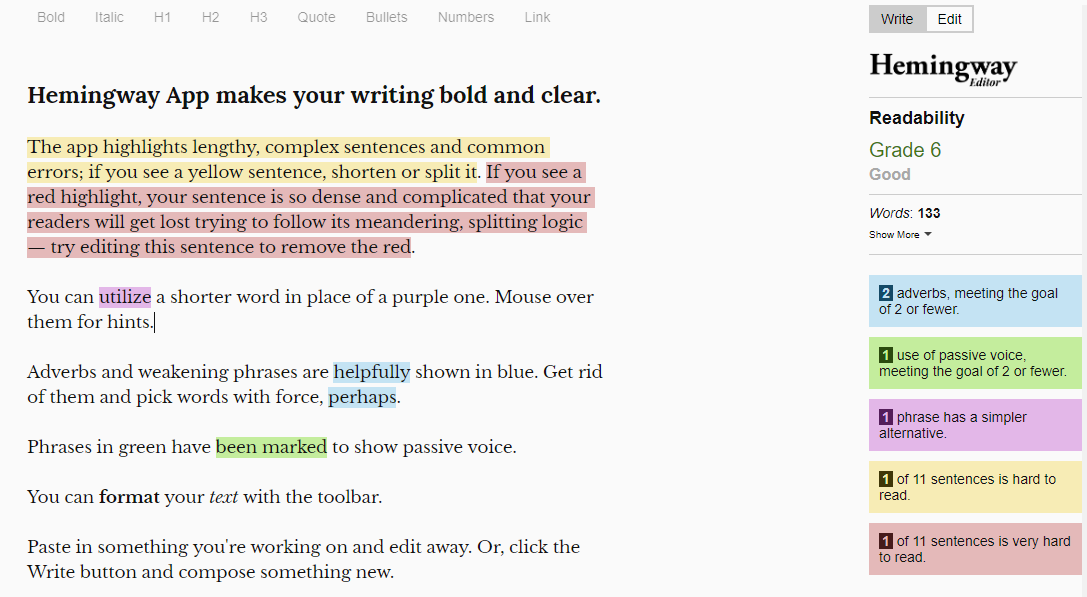
On a side note, use tools like Grammarly and Hemingway App to keep a check on the grammar and readability of your content. Poor grammar and bad readability can negatively affect SEO and also lowers your perceived expertise in the eyes of the readers. So, investing some effort in writing “quality” content is definitely going to be worth it.
Anyway, here are a few actionable tactics you can apply:
Partnering Up with Industry Leading Tools
If you are writing content that involves heavy inclusion of numbers and statistics, it would be a good idea to partner up with companies which can provide you with some vital insider data.

For this, you can reach out to them via email and ask if they would be interested in helping you with your content. In return, they would get increased brand recognition. It’s a win-win.
For example, Fractl partnered with BuzzSumo to look at the 1 million most-shared articles from the first six months of 2016. So, if you’re writing content on search engine marketing and need to include some key statistics on the topic, you can consider partnering up with SEMrush.
Writing Long-Form Content
Like it or not, size matters, especially when it comes to content marketing. If we talk about writing blog posts and “how-to” guides, studies conducted by all the big names in content marketing point towards the fact that long-form content tends to perform better than short-form in terms of rankings, social shares, and earning links.
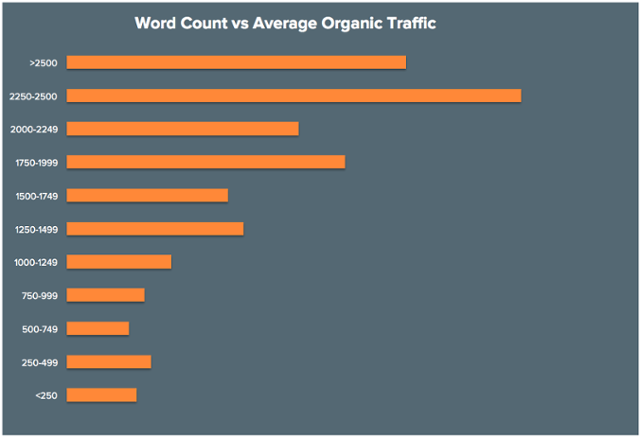
But writing long-form content shouldn’t translate into merely inflating wordcount and compromising on quality. It won’t work if you blow up a topic which you can cover in 300 words to 3000.
Writing long-form content means comprehensively covering the topic and answering all the questions a reader might have, which ultimately adds value and establishes your thought-leadership. More often than not, it would automatically mean your post reaches 1500-2000 words, which is supposedly the ideal length for a blog post.
Using the “Skyscraper Technique”
Backlinko’s Brian Dean coined this content marketing buzzword back in 2016 and the technique is a prime example of data-driven content marketing. It’s simple and works well even today.
Here’s a summary of the technique:
- Find content on the topic you want to write about which has already done well in terms of rankings, social shares, and attracting links. The easiest way to do this is performing a simple Google search. The content on the first page of Google (especially at the very top) is bound to have a ton of backlinks (and social engagement) pointing to it.
- Then, take that content and make it even better. Keep in mind, “take that content” does not mean hitting CTRL+C and CTRL+V. Instead, it means you have to do any (or all) of the following:
- Find out what it is about that piece of content which made it so popular and sought after to rank at the very top. Uncover gaps in that content and then make it more thorough, as there might still be parts of the question that this content did not answer, or did not elaborate enough on.
- Make the content more up to date. Google prefers to rank fresh content at the top. So, if you find content sitting at the top of the results which is out of date, then simply write a more updated version of it. Include more recent statistics or elaborate on what changed since the last time this topic was written about. Voilà, now you have the edge.
- Improve the design of the content. The importance of having a good user interface and user experience cannot be overstated. So, invest in producing the best design and make your content stand out.
- Now, once you have the content ready, it’s time to spread the word. Specifically, find the people who are linking to the inferior content and let them know what you have is better in terms of depth, relevance, and/or design.

And that’s it. Applying this strategic, data-driven technique when creating long-form content is a reliable way to achieve high rankings.
Also, it is worth mentioning again: it’s time you focus on user intent if you wish to rank well in search results. Brian Dean’s got you covered on that too with his “Skyscraper Technique 2.0”. Use both these techniques simultaneously to achieve as well as maintain your rankings.
Content Repurposing
Smart content marketers know it is not always about creating new content. If you already have a sizeable repository of content, you should consider leveraging it in new formats.
In simple words, content repurposing is the recycling of your existing content to reach and capture new audiences. For example, some people prefer watching videos over reading blog posts. So if you reformat your blog posts into videos, you have the opportunity to gain a completely new audience.

There are a couple more advantages of repurposing content:
- Helps identify popular content: You might have noticed some content performs significantly better than others. Dig deep into your analytics and try to find out why that’s the case. Repurposing such content is a surefire way to succeed in your future marketing efforts.
- Helps identify evergreen content: Not all content you create will last forever in terms of relevance. But it doesn’t mean it has to fade away. Go back to that blog post, ebook, infographic, or whatever it may be, and give it a nice touch-up. Keeping old content updated by regularly adding relevance to it (and then repurposing it) is another surefire way to soar your rankings.
If you have a series of blog posts covering a single topic in-depth, you can repackage them into an e-book. This is a great way to generate new leads and earn more email newsletter subscribers.
Similarly, you can turn your most popular blog posts into podcasts. The popularity of podcasts has risen dramatically in the past few years.
These are just some of the many ways to cleverly repurpose content and get the most bang for your buck.
After Content Creation
A smart marketer knows creating quality content is only half the battle won. Writing great content will surely put you on the path to success, but it takes much more than that to really win at content marketing.
Here’s how to proceed after creating quality content:
Promoting Your Content
“Write less, promote more” is a common strategy advocated by smart content marketers. In fact, some of them go to the extent of saying that the work-promoted-to-work-produced ratio should be on the lines of 80:20. That means whipping up a blog post in two hours and then trying to find creative ways to promote it the rest of the day.

This seems like an extremely aggressive marketing strategy. So don’t take it literally. By all means, spend as much time as it takes to produce truly valuable content. But, once you do have substantial content (of high quality) under your belt, it makes sense to go all out with content promotion.
Depending on the type of content and budget, here are a few data-driven ways to go about promoting your content:
Sending Personalized Emails
When you are reaching out to potential websites for guest blogging and link building opportunities, you need to keep the following things in mind:
- Study the recipient’s website and business meticulously before reaching out
- Read the guest posting (or contributions) guidelines if available
- Find out what their interests are and how your proposal would be mutually beneficial
- Keep the subject line succinct
- Use their name in the salutation
- Clearly introduce yourself and what the email is about
- Show them that you’ve spent time reading their website or blog. Mention your favorite article or two
- Suggest topic ideas for the guest post if required
- Share a few examples of your previous work
- Don’t seem desperate or pushy, just be warm and nice
- End with a “Sincerely” or “Best/Warm regards” along with a signature and contact details
- Using an email template is fine, but make sure to tailor every email to the recipient
Here is a good example of how to outreach for guest posting:
Hi Ken,
My name is Regina Phalange and I am the Founder and CEO of Relaxi-Taxi, an on-the-go massage service for extremely busy people.I am an avid reader of your blog Lazy Boy and your recent post on “How to Relax Like a Boss” was really awesome. I especially liked the point you made on yawning on demand.
As a matter of fact, I’ve been brainstorming some topics myself that I think your readers would get a ton of value from:
<Idea #1>
<Idea #2>
<Idea #3>
I’ll make sure the piece overflows with actionable and unique content.
To give you an idea of the quality I’ll bring to your site, here are a couple of links to posts that I recently published on related topics:<Link #1>
<Link #2>
Looking forward to your earnest response. Cheers.
Sincerely,
ReginaFounder & CEO, Relaxi-Taxi
Now, check out this email:
Hi there,
I am Regina Phalange and I really like your blog.
I would like to contribute a guest post in exchange for a link back to my website.
Here’s a topic that I think your readers would enjoy:
<Bland Topic>
Let me know what you think.
—
Regina
Yes, you’ve guessed it. Such an email would obviously be considered spammy and won’t work.

On the other hand, when it comes to bottom-of-the-funnel content marketing, personalization obviously doesn’t mean sending an individual email to each and every recipient. Instead, it means using data collected from the audience (using sign up forms) to create a personalized email. So, instead of “Hi there”, you can go for “Hi <name>”.
As the recipient’s inbox is likely crowded with many such emails, use their first name in the subject line to grab their attention. According to this source, a personalized subject line can increase email open rates by 16%.
Also, to make your email truly personalized, use your real email signature (with contact details) and real reply-to email address (not “donotreply@example.com”).
Check out this example from Billy Gene is Marketing:
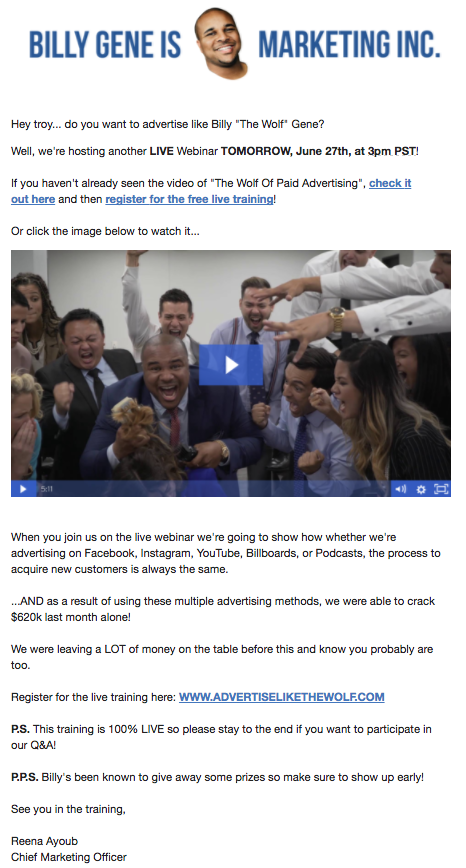
Note how it uses a bit of humor and an informal tone to make the email an engaging read.
According to the same source, approximately 70% of brands still don’t use personalization in their email marketing strategy. So, doing so will definitely help you stay ahead of the curve.
Consider using tools like ConvertKit or AWeber for personalizing your email marketing.
Leveraging Social Media Influencers
While it’s important to understand your target audience and what they are talking about, it is also important to realize who they’re listening to. Promoting content by simply sharing it on Facebook, LinkedIn, and Twitter won’t work wonders anymore.
Influencer marketing is the next big thing in social media and many brands are already leveraging it. According to Demand Gen Report, 87% of B2B buyers give more credibility to content shared by industry influencers. In other words, when brands pay social influencers to market their products, they are gaining the trust of an audience that they wouldn’t otherwise have had access to.
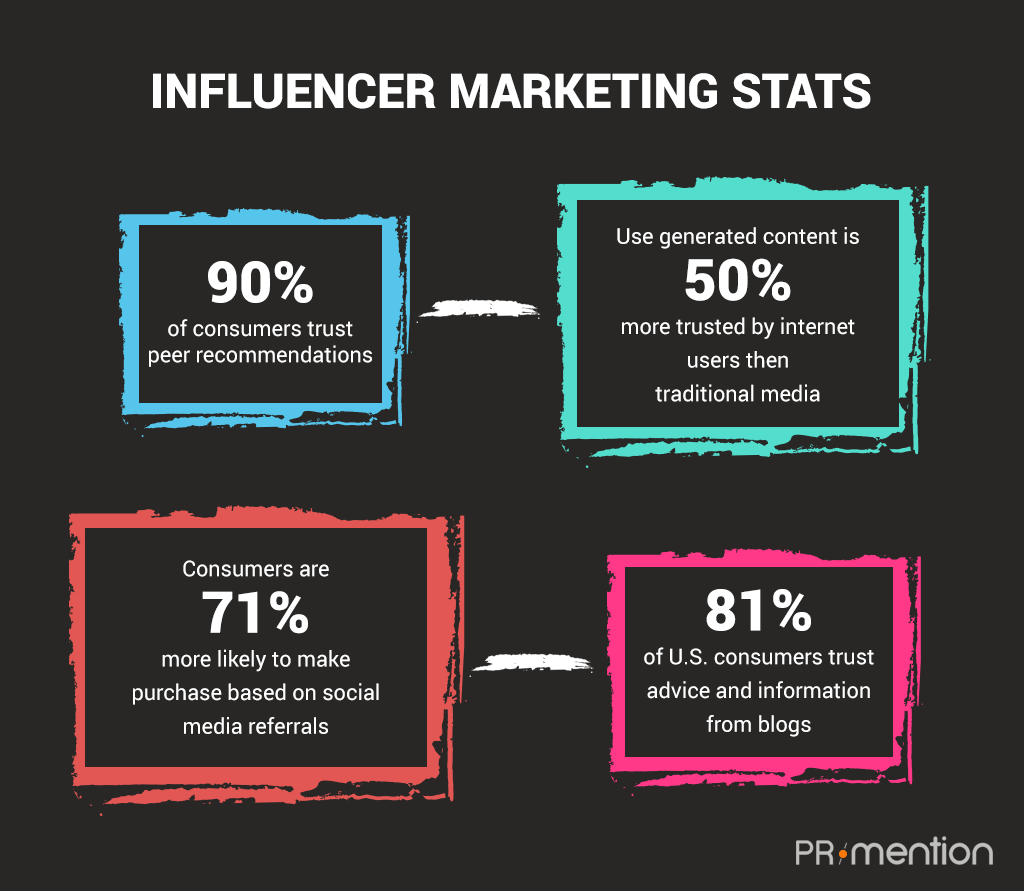
Influencer marketing works for all industries. For example, if you are in the gadget industry, getting Marques Brownlee (from MKBHD) to review your product and share the same on their social media channels can bring you an incredible exposure which simply cannot be achieved by conventional marketing methods.
Tools like Followerwonk, TapInfluence, and Upfluence can help you identify the right influencers for your budget.
Try Creating Video Content
Video content is on the rise. While it is debatable whether the written word will completely go out of fashion, video marketing is definitely booming and companies are starting to recognize that. A few “fun” facts for you content marketers:
- Video will account for more than 80% of all internet traffic by 2021. (Cisco, 2018)
- If video and text are both available on the same page, 72% of people will watch the video to learn about a product or service rather than read the text. (HubSpot, 2019)
- Using videos on landing pages will increase conversions by 86%. (Wordstream, 2018)
Video content works remarkably well on all social media platforms, and you must have witnessed that first-hand. And inevitably, YouTube is what comes to mind if you think, talk, or do video.

While YouTube marketing has picked up rather quickly in the last couple of years, you would be surprised to know that YouTube is still a very underutilized platform when it comes to personal and business branding. But as already mentioned, brands are taking notice of this trend and starting to adapt as quickly as possible.
2019 will see a dramatic increase in the already astonishing level of video consumption happening on YouTube every day, worldwide. So, having a good YouTube presence for video content marketing will soon be a necessity for content marketers. Check out this post to learn how to kickstart a YouTube channel from scratch.
Using Paid Promotions
Considering the fact that an average of four million blog posts are published online each day, using paid promotions to get more eyes on your content is definitely not a bad idea.
It allows your content to be seen by a highly targeted audience in incredibly competitive niches. Would you rather receive 50,000 page views from visitors that convert at a rate of 0.1% or 1,000 visits from qualified prospects who convert at a rate of 10%?
So, being able to target a highly specific audience with paid advertising can certainly pay off.
For paid content marketing, the strongest platforms are Google Ads and Facebook. However, as mentioned above, YouTube is just around the corner.

Native advertising is also a good option as it is inherently non-disruptive. That is, native ads don’t look like traditional display or banner ads, because they match the look, feel and function of the media format in which they appear. So, they look more like editorial content which increases the likelihood of your content being clicked-through to.
However, people nowadays are savvy enough to easily recognize ads and tend to use ad blockers to stay away from them. Still, popular native advertising platforms like Outbrain and Taboola work well.
Read this post by Single Grain’s Eric Siu to get a more comprehensive idea about using paid promotions for your content.
A/B Testing Titles and Meta Descriptions
As you may already know, split testing or A/B testing is a method of website optimization in which you segregate your traffic into two versions of the same page (version A and B) and then their conversion rates are compared over a period of time.
It is usually employed to optimize landing pages during Conversion Rate Optimization (CRO). However, as a content marketer, you can utilize split testing to test different SEO titles and meta descriptions and find out which gets the most click-throughs.
Tools like Optimizely and ClickFlow are worth checking out.
Measuring Results
In the end, it’s all about the ROI, really. And measuring your content marketing performance can seem a bit challenging as there are so many factors that come into play.

Of course, every campaign (and business) has different KPIs, but the below-mentioned ones should point you in the right direction:
- Unique Visitors: Indicates the total number of unique visitors to a particular page on your website. It helps determine the scope of your audience.
Google Analytics: Audience > Overview > New Users
- Pages per Session: Indicates the average number of pages viewed during a single session on your website. It gives you an insight into how well your content is organized so as to drive the visitor to view more pages on your website. If your website (or blog) has proper internal linking and overall intuitive experience, then users are more likely to hang around.
Google Analytics: Audience > Overview > Pages / Session
- Dwell Time: Indicates the average amount of time a visitor spends on your website before returning to the SERPs. If a user clicks through to your website but quickly returns to the search results, it sends a negative signal to the search engine and reflects in poor rankings. So, this is an important metric for your SEO.
A low bounce rate and high time on page signify a high dwell time.
- Engagement: Indicates how much your content resonates with your audience. A high amount of likes, shares, tweets, pins, and comments on the post are a good indication of high engagement.
- Organic Traffic: Indicates the number of visitors you received from a search engine’s results page. If your organic traffic is low, it means that your post or website is not optimized for search engines. Consider looking into SEO.
Google Analytics: Acquisition > All Traffic > Channels > Organic Search
- Inbound Links: Also known as backlinks, inbound links are one of the most important ranking factors for Google. A high number of links from unique domains (with high authority) pointing towards your content is a very good indicator of quality content.
Google Analytics: Acquisition > Campaigns > Organic Keywords
- Lead-close Rate: As a content marketer, you would want to know (and track) which of your leads can be specifically attributed to your content marketing efforts. This metric gives an insight into the same.
Google Analytics: Conversions > Multi-Channel Funnels > Assisted Conversions
- CTA Click-Through Rates: Use the Click-Through Rate of your various CTAs to see how individual pieces of content are performing throughout your funnel. Improving Call-To-Actions in and around your content can dramatically improve your lead closure and conversion rates.
Gathering Feedback
Ultimately, attracting (qualified) strangers to your website and turning them into promoters for your brand is the inbound way of content marketing. While metrics and KPIs help monitor performance, getting feedback (and criticism) from your audience is the only way you can understand what’s going wrong and how you can constantly improve your marketing efforts.

Your community won’t mind answering a little survey form every now and then, and such data is absolutely crucial to driving your content marketing onward and upward!
Key Takeaways
So while content marketers are indeed a creative bunch of individuals who play with words and visuals to drive traffic to their client’s website, there is a lot of left-brained activity involved in their work as well.
Moreover, content marketers who use data every step of the way to drive their campaigns forward have the best chance of avoiding fruitlessness.

Here are the key points you need to take away from this guide:
- Invest time in understanding your audience by creating detailed buyer personas and leveraging Google Analytics.
- Focus on user intent when performing keyword research because semantic search is here. Answer as many of the user’s questions as you can by comprehensively covering the topic.
- Survey your audience to understand what they truly like/dislike and tailor your strategy to their responses.
- Creating a content calendar is a very worthy investment of time.
- Partner up with industry-leading tools if creating content revolved around numbers and statistics.
- Use the “Skyscraper Technique” to write long-form content that is bound to get rankings and recognition.
- Content repurposing will help you extract the most juice from your top performing content.
- Personalized emails are an absolute must.
- Leverage influencers to spread the word faster and more effectively.
- Video marketing is about to enter its prime and can’t be ignored anymore. Consider leveraging YouTube (and Facebook videos) sooner rather than later.
- Split test titles and meta descriptions for better on-page SEO
- Measuring the performance of content marketing campaigns is admittedly tough. However, identifying a few KPIs (see above) will help.
- Gathering website feedback from the audience and using the data collected for constant improvements is pivotal to long-term success.
So there you have it, some simple yet powerful ways to take your content marketing campaigns to the next level and yield a higher ROI. The perfect combination of data and creativity is what makes a content strategy foolproof.
What do you think constitutes a great content marketing strategy? Feel free to leave your two cents down in the comments. Cheers!
Arkin Khemchandani is a Content Marketer at Growfusely. A self-proclaimed and proud introvert, he loves spending time at the beach. Creating quality content has been his drive for quite a while now, and he is a firm believer in the Inbound Methodology. In his spare time, he enjoys playing football, listening to music, go-karting, and gaming. Connect with him on Twitter: @arkin008


